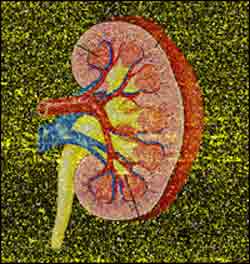A global view of gene expression in the aging kidney

Genome-wide analysis of aging in the human kidney. Photo illustration by Rebecca Sonu and Emily Crane.
Four years ago in Science, Stuart Kim, a Stanford University developmental biologist, made the case for describing the broad strokes of a complex physiological process before defining its mechanisms. “A powerful, top-down, holistic approach,” he wrote, “is to identify all of the components of a particular cellular process, so that one can define the global picture first and then use it as a framework to understand how the individual components of the process fit together.” To get a broad view of gene expression in the developing nematode, Kim’s lab turned to DNA microarray technology. In a new study, Kim and colleagues apply this same approach to the decidedly more complex problem of human aging and “present a molecular portrait” of the aging kidney.
Kidneys came from 74 patients, ranging in age from 27 to 92. Samples were extracted from donated kidneys or “meticulously harvested” from kidneys with localized disease to ensure only normal tissue was taken. Samples were obtained from two structures that are critical to kidney function: the renal cortex, which filters plasma, and the medulla, which alters urine composition to maintain fluid balance. Both deteriorate with age.
Kim and colleagues then used DNA microarrays to determine the activity of every gene in all the kidney samples. Of 33,000 known human genes on the microarray, 985 showed age-related changes.
Although cortex and medulla have different cell types and perform different functions, their genetic aging profile was very similar, suggesting a common aging mechanism operates in both structures. In fact, these mechanisms may function broadly, as most of the age-regulated kidney genes were also active in a wide range of human tissues. Other organisms appear to lack these changes, however, prompting the authors to argue that understanding aging in humans will require human subjects.
Most importantly, the genetic profile of the tissue samples correlated with the physiological decline of an aging kidney. An 81-year-old patient with an unusually healthy kidney had a molecular profile typical of someone much younger, while a 78-year-old with a less healthy kidney had the profile of a much older person. Using the power of functional genomics, this study has identified a set of genes that can serve as molecular markers for various stages of a deteriorating kidney. These gene sets can also serve as probes to shed light on the molecular pathways at work in the aging kidney, and possibly on the process of aging itself.
Media Contact
More Information:
http://www.plos.orgAll latest news from the category: Life Sciences and Chemistry
Articles and reports from the Life Sciences and chemistry area deal with applied and basic research into modern biology, chemistry and human medicine.
Valuable information can be found on a range of life sciences fields including bacteriology, biochemistry, bionics, bioinformatics, biophysics, biotechnology, genetics, geobotany, human biology, marine biology, microbiology, molecular biology, cellular biology, zoology, bioinorganic chemistry, microchemistry and environmental chemistry.
Newest articles

Machine learning algorithm reveals long-theorized glass phase in crystal
Scientists have found evidence of an elusive, glassy phase of matter that emerges when a crystal’s perfect internal pattern is disrupted. X-ray technology and machine learning converge to shed light…

Mapping plant functional diversity from space
HKU ecologists revolutionize ecosystem monitoring with novel field-satellite integration. An international team of researchers, led by Professor Jin WU from the School of Biological Sciences at The University of Hong…

Inverters with constant full load capability
…enable an increase in the performance of electric drives. Overheating components significantly limit the performance of drivetrains in electric vehicles. Inverters in particular are subject to a high thermal load,…





















